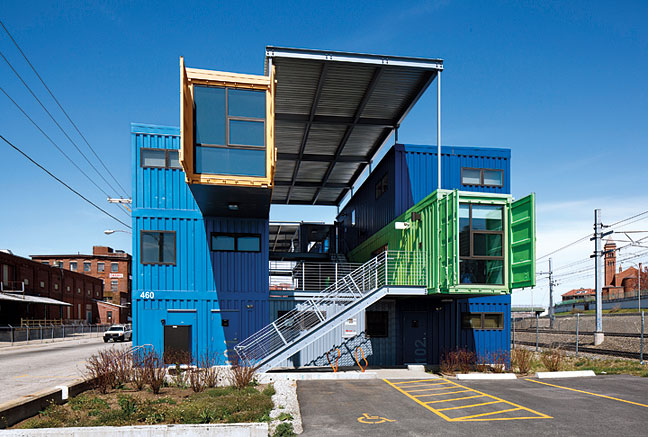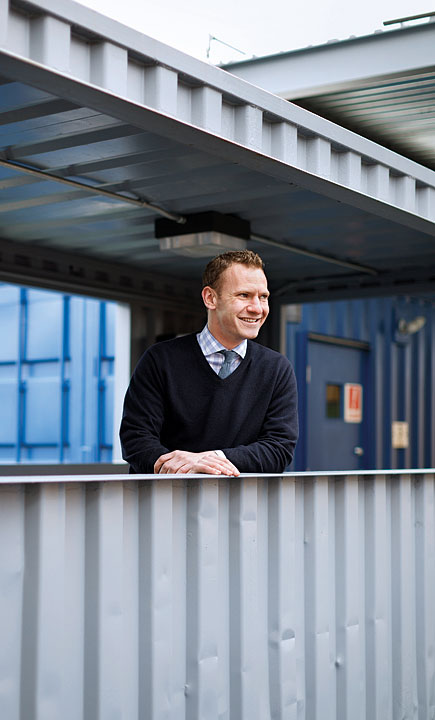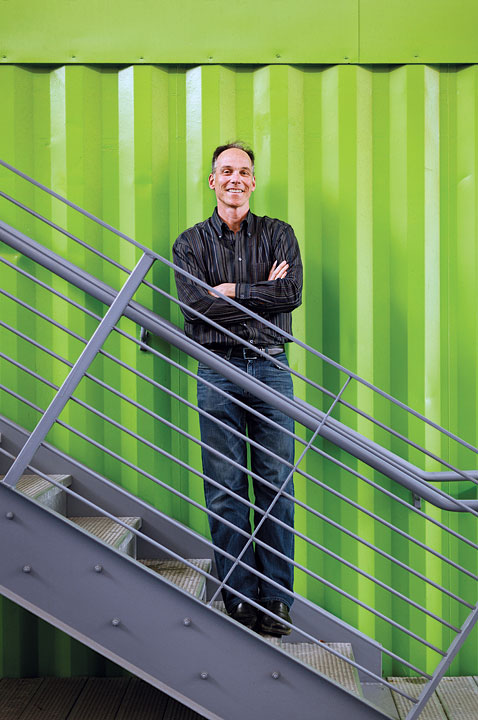In September 2008, Joshua Brandt ’04 strolled through a seventy-acre riverside lot in Newark, New Jersey, in search of a new kind of green building. He was surrounded by discarded corrugated-steel shipping containers, each one nineteen feet long, eight feet high, and eight feet wide. He estimates there were tens of thousands of them piled there in sixty-foot-high stacks. It was a landscape he describes as “borderline post-apocalyptic.” The sound of his footsteps bounced off the steel to produce a quiet metallic echo.

The result is that lots like this one in Newark can be found near every major shipping port in the country. A University of Southern California study of West Coast ports found that only half the containers that arrived there since 1998 were sent back. The Port Authority of New York and New Jersey reported that the Newark-Elizabeth complex unloaded more than 2.58 million shipping containers in 2010, but shipped back only 59 percent, leaving more than a million stacked in the hope that one day the economics of shipping will shift and the containers can head out to sea once again.

But what if they could become buildings? What if they could provide low-cost office space, and even housing? Brandt knew that this was already being done in Europe. The Travelodge Hotel in Uxbridge, England, for example, is made from eighty-six containers, and London’s Container City in Docklands comprises thirty-seven live-work spaces that originated as shipping containers. In Amsterdam, TempoHousing solved a 2006 student-housing shortage by assembling containers that could provide shelter for more than 1,000 students.
The commercial use of shipping containers has been slower to develop in the United States. Most projects have been temporary and gimmicky. The Illy coffee company’s 2007 Push Button House unfolded into a chic, open-air, five-room house, complete with a library. The athletic-wear giant PUMA opened a shipping-container store at Boston’s Fan Pier that could be fully disassembled and moved to other profitable locations. The 45,000-square-foot Nomadic Museum was also built to be temporary, moving from New York City to Santa Monica, California, and then to Tokyo.
Providence building developers at Truth Box Inc. and designers at Distill Studio worked with Brandt’s firm, Stack Design Build, to envision viable permanent structures. As the builder of the project, Brandt scavenged the Newark riverside lot to select thirty-five matching containers, each with about a decade’s worth of use. He would stack the compartments to build a 12,500-square-foot office complex on the west side of Providence. The complex, appropriately enough, is called the Box Office.
When he was a kid growing up in Rochester, New York, Brandt says, “my absolute favorite toys were Legos. When I would get a new set for Christmas, I would tear open the box and build what the instructions said in an hour, look at it for like ten minutes, then take it apart and build my own stuff.” He had so many Legos that his mother provided labeled sorting bins to keep them organized.
Brandt draws a distinction between Legos kids and lemonade-stand kids. The latter are about selling, while the former are about building. Legos kids, he says, buck established trends, preferring to invent new things; they espouse “freedom, hard work, innovation, making something new.”
Brandt’s parents were both lawyers, and, although his brother became one, too, it was something his parents discouraged. Brandt was an engineering concentrator at Brown, where he developed his capstone project in structural steel design. During one summer he helped build luxury condominiums on the water in Bristol, Rhode Island, as the assistant to a building project engineer. While working, he was disappointed at the small role an engineer plays in such a project. He wanted to experience a building from start to finish, learning as much as he could about each of its components. He began to dream of making a building completely from scratch. “I’ve always been creative, but not in the usual way,” Brandt says. “I was more creative in the engineering, figure-it-out, put-something-together way rather than in the visual, aesthetic way.”
“I’ve known I wanted to start my own business long before I knew what that business would be,” he says. “Some people are wired for entrepreneurship. They have a desire to do it better, faster, cheaper.” Brandt founded his company, Stack Design Build, as a firm that would envision and innovate with projects and materials few others had worked with before.
The shipping containers allowed him the design freedom he had imagined. “Shipping containers were a perfect product of a free market economy,” he says. They had to be strong, easy to move, and inexpensive to build. “What resulted was a steel body so perfectly designed that, if you removed anything, it would fall apart.” That seemed to make them ill-suited for human habitation. The walls rely on one another to hold the structure in place, so installing a window or a door or pipes would cause the container to collapse. It was a problem Brandt wanted to solve.
The analogy Brandt makes is to an orchestra. In a traditional building, a variety of different parts play together harmoniously, with the guidance of a conductor. A shipping container, he says, is like ”some big, loud instrument that no one has ever played.” It was screeching, overpowering, off-tempo. All the other instruments had to adjust to the corrugated metal one before anything could proceed.
Brandt’s first real success was building a medical clinic made from two shipping containers for Containers2Clinics, a Boston-based NGO that uses shipping containers as primary-care centers in developing countries, particularly in rural settings. Just as Stack Design Build finished its prototype clinic, the catastrophic 2010 earthquake hit Haiti. The Stack Design Build clinic was sent as part of the disaster relief program.
The Box Office, however, presented challenges on a new scale. The first was cost. Although the containers themselves are abundant and cheap, assembling more than thirty of them into a permanent building proved expensive. “For every dollar that we spent purchasing the containers,” Brandt says, “we spent $3.50 tearing away walls, cutting out huge portions, adding columns, building doors, windows.”

Brandt also wanted the Box Office to make a statement about sustainable building. Environmental awareness and sustainability seem like obvious core values to his generation, he says, but when he graduated in 2004 he noticed they were still low priorities in the building community. He is on a mission to change that. So the problems surrounding the window installation inspired an efficient insulating system. The space between a window and a wall is an ideal escape point for heat; Brandt developed a system that combines spray foam insulation with fiberglass batts to create an unyielding air barrier. Although Brandt calls this “Green Building 101,” he says that many people do not take these small energy-saving steps.
“People are often only into visible energy efforts, not the tiny
efforts to make a building more efficient. They think of solar panels
and vegetated roofs. This thermal bridging doesn’t cost extra, and
takes maybe five minutes to put in.” As a result, the high initial
costs of building the Box Office have been partly offset by its low
utility bills. Annual utility spending for the average New England
building, Brandt says, is $2.25 per square foot. The Box Office cost
for the same period is ninety-five cents. Brandt’s original goal was to
reduce the average building’s energy consumption by 25 percent; so far
the figure is 68 percent.
When I visited Brandt on an afternoon last fall, he showed me around
the only office in the complex that was unfinished. “Most builders
wouldn’t want to touch this with a ten-foot pole,” he comments. The
room is a cluttered mess: insulation is strewn about in fluffy pink
tufts, brightly colored wires dangle from the ceiling, and exposed
pipes are wrapped in shiny insulating foil. The ribs of the containers
look like metal corduroy.
The Box Office finally came about when in April 2008 developer Peter Gill Case ’83 hired Stack Design Build to design an upscale office complex—“where that dirt pile is now,” Brandt says, pointing. When the economy began to collapse later that year, Stack Design Build, along with designer Joe Haskett of Distill Studio, decided that a building made of shipping containers would give renters a splashier, more cost-effective alternative to the traditional upscale office building.
The result is marvelous. The outside walls of the containers have all been painted in whimsical crayon tones: glowing green, electric blue, bright orange. The finished offices inside are sleek, stylish, and narrow. Many of the interior doors hold glass panes, sometimes frosted, to emphasize the length of the interior. The entire structure consists of thirty-two containers stacked three stories high. There is nothing quite like it in the United States; it is the first and largest permanent multistory shipping-container building in the country. Its closest rival is a Redondo Beach, California, two-story home constructed from eight containers in 2006 by DeMaria Design and Logical Homes. It’s hard to believe that a decade ago all the units making up the Box Office were hauling assorted goods across the world’s oceans. On this unlikely Providence lot, they have become a marriage of beauty and ecofriendliness.
“This building,” Brandt boasts, “plants the flag of cool high design in shipping-container buildings, not just in the U.S., but in Providence.” The play between indoor and outdoor spaces is innovative and striking. Most designers stack the containers, much as they would be stacked on a ship. At the Box Office, they are arranged in an overlapping fashion—not unlike Legos. Some of the containers are cantilevered, creating visual drama and engaging people passing by. “From day one, we recognized that this was going to be iconic,” Brandt says.
Icon or not, businesses are moving in. Even in a down economy, the occupancy rate at the Box Office is 90 percent, despite the building’s location on an abandoned industrial site near an interstate and train tracks. If the building had not been made out of shipping containers, Brandt believes, its 12,000 square feet would just be more vacant Providence office space.
Now, as a train rumbles past the Box Office nearly at eye level,
watching it from inside the narrow rooms gives the illusion that it’s
the shipping containers that are still moving, still hauling their
cargo to the next destination.
Thanks to works like the Box Office, the future of buildings made from
shipping containers is bright. For clients interested in
energy-efficient buildings made from reused materials, they make a
statement. “It’s branding identity,” Brandt says. “It’s a statement,
something everyone notices.”
Barry Naef, the managing director of the Intermodal Steel Building Units and Container Homes Association, says that in 2012 the number of shipping-container homes is expected to double, bringing the total number to about 4,000 units. Naef notes that this doesn’t even include the biggest consumer of shipping containers used for shelter: the Department of Defense, which likes both their durability and the speed with which they can be assembled. (The DoD does not disclose the number of containers it consumes.)
“If the global economy is a human body,” Brandt says, “shipping containers are its red blood cells. They are integral to global commerce. They have changed the world. Their use in shipping-container buildings is more than symbolic. What was once the lifeblood of the global economy can contribute to the local economy.”
Former BAM intern Maggie Lange is a freelance writer.




